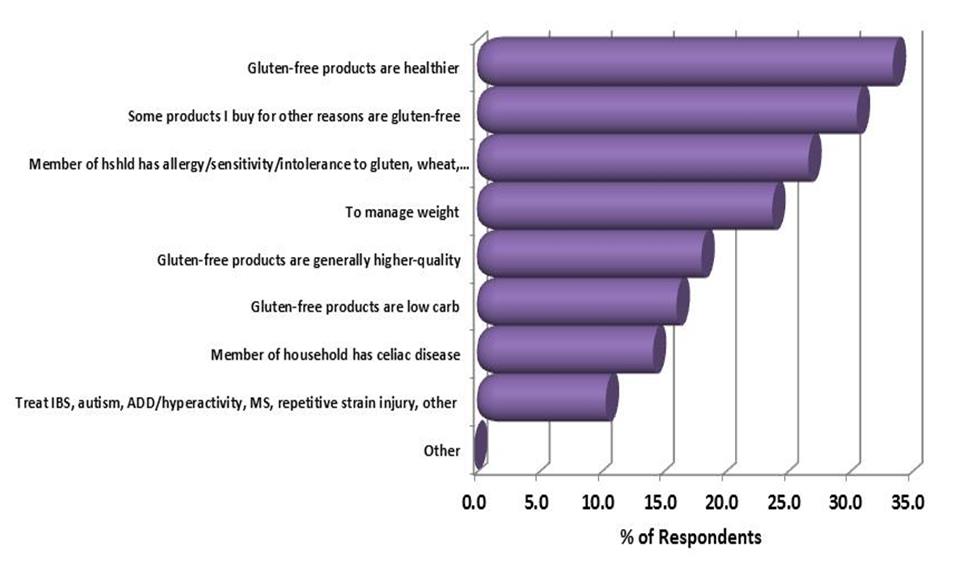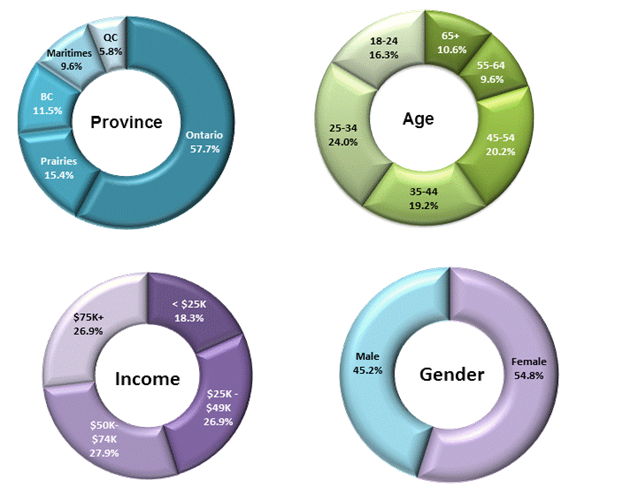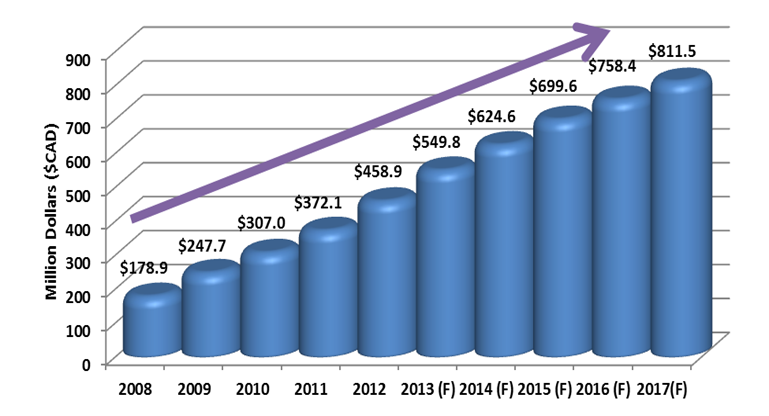| | Introduction | Reasons Canadians buy gluten-free foods | Canadian gluten-free food consumer | Sales are soaring! | Did you know? | What does this mean? | Footnotes
.
Introduction
According to a recent market research study, the gluten-free food market has exploded and is expected to continue growing well into 2017 amounting to about $811 million in product sales1. We have all seen and heard about gluten-free foods, but what does this term really mean? How many people are going “gluten-free” and why?
In this issue, we examine the gluten free market to provide information that may be beneficial for Alberta’s agri-food industry.
What is gluten?
Health Canada defines gluten as a protein found in wheat, rye, triticale, barley, kamut, spelt and oats. Although oats do not contain gluten the milling process can result in cross-contamination with gluten. The gluten in flour helps bread and other baked goods bind and prevents crumbling. This feature has resulted in gluten being widely used in the production of many processed and packaged foods.2 Health Canada’s Food and Drug Regulations limit gluten to 20 parts per million in foods labeled “gluten-free”.
.About 1% or 355, 000 Canadians have Celiac disease
and 2.1 million may be gluten intolerant.
Why do consumers buy gluten-free?
According to a recent survey 3, as illustrated below, over one third of Canadians who purchase gluten-free products generally considered gluten-free as healthier than equivalent gluten-containing food products and about one quarter purchased gluten-free foods to manage their weight. Most notable is that the majority of Canadians purchase gluten-free because they perceive gluten-free to be healthier and better quality rather than purchasing for specific medical conditions such as Celiac disease.4
Reasons Canadians Buy Gluten-Free Foods 5

Source: Packaged Facts, August 2012 Survey
Who is eating gluten-free?
The results of a 2012 Canadian survey6 indicate that about 73% of those who bought gluten-free food in the past 30 days also said they were buying more gluten-free products than previously. Slightly more female respondents said they purchased gluten-free products. Ontarians were the greatest gluten-free food purchasers in Canada. The largest percentage of gluten-free food purchasers resided in the 25-34 age category and over half of gluten-free product purchasers had household incomes of over $50,000 per year.
Canadian Gluten—Free Food Consumer

Source: Packaged Facts August 2012 survey
Note: Figures are based on a national online consumer panel of 500 Canadian adults (age 18+) balanced to Census on gender, age, race/ethnicity, geographic region, marital status, presence of children in the household, household income. Percentages correspond to 104 gluten-free food product consumers included in the sample. Multiple responses were permitted.
Sales are Soaring!
The Canadian gluten-free market has experienced significant growth with sales soaring from $178.9 million in 2008 to nearly $460 million in 2012. Growth is forecasted to increase to about $811 million in 2017. 7
One of the key growth drivers is thought to be the evolution of products once sold exclusively at specialty marketers into the mainstream retail market. This makes these products more accessible to all consumers.
| Canada Retail Sales of Gluten-Free Food, 2008 – 2017 |

Source: Gluten-Free Foods in Canada, published by Packaged Facts a US based publisher of market research

What is the problem with gluten?
Gluten is an issue for some people that have a sensitivity to it, particularly for individuals with Celiac disease.
What is Celiac Disease?
Celiac disease is a genetically-based autoimmune disorder where gluten damages the small intestine.8
According to Health Canada the immune system of a Celiac reacts negatively to the presence of gluten in the diet causing damage to the inner lining of the small bowel which reduces the person's ability to absorb nutrients including: iron, folate, calcium, Vitamin D, protein, fat and other food compounds.
Celiac disease can appear at any age in a person with a genetic predisposition. A number of factors can trigger the onset of symptoms.9 Factors such as emotional stress, pregnancy, surgery or an infection can sometimes trigger the onset of symptoms.
Currently there is no cure for Celiac disease, but it can usually be effectively treated and controlled by a strict adherence to a gluten-free diet.

What does gluten-intolerant mean?
Some individuals, while not Celiacs, experience an adverse reaction (abdominal pain, bowel issues, fatigue, headaches and paresthesia (tingling of the extremities) when they consume gluten. The symptoms are usually transient. It is thought that 2.1 million Canadians suffer from gluten intolerance.10
Did you know?........
According to information published by Packaged Facts, a US market research company:
- About 1% of the population have Celiac disease. In practical terms, the number of Canadians affected is much larger when you consider the family and friends who share meals and snacks with those who are afflicted.
- However, of those Celiacs only two-thirds have been diagnosed.11
- It can take up to 12 years for Celiacs to receive a proper diagnosis.12
- The incidence of Celiac disease has doubled every 15 years since 1974.13
Where is gluten-free food sold?
Gluten-free food products were once sold only in specialty health food markets, but now they have gone mainstream. You can find gluten-free foods at major grocery retailers including Safeway, Sobeys, Loblaws, Save-On Foods, Shoppers Drug Mart and even HomeSense, among many others.
Are restaurants ready for gluten-free?
Restaurants are also getting into gluten-free with many offering some type of gluten-free item on their menus. This trend will continue to grow. According to Garth Whyte, CEO of Restaurants Canada: “The Canadian diner has a heightened awareness of food intolerances, allergies and ingredients, and chefs are taking note. We’ve created a restaurant-focused food allergy guide to help our members cater to customers’ diverse needs in a safe environment.” 14
This sentiment is supported by the 2014 Restaurants Canada Canadian Chef Survey of over 400 professional chefs who ranked “gluten-free” as the hottest trend in 2014.15
Restaurants Canada’s 2014 Chef Survey - Top 10 Hot Trends in 2014
Ranking | Menu Item |
1 | Gluten-free/ food allergy conscious |
2 | Quinoa |
3 | Locally sourced foods |
4 | Leafy greens (e.g. kale, Swiss chard, mustard greens, collard greens, dandelion, beet greens) |
5 | Craft beer/ microbrews |
6 | Food smoking |
7 | Heirloom fruit and vegetables (e.g. tomatoes, beans, apples) |
8 | Charcuterie/ house-cured meats |
9 | Food trucks |
10 | Inexpensive/ underused cuts of meat (e.g. beef cheek, brisket, pork shoulder, skirt steak). |
Source: Canadian Restaurant and Food Service Association
What Does this Mean?
- There are still opportunities for Alberta’s primary and processing industry to capitalize on the growing demand for gluten-free food.
- As awareness of Celiac disease increases, the rate of proper diagnosis could also spur demand for gluten-free food from this consumer market segment.
- More restaurants are offering gluten-free menu items, which increases opportunities for Alberta food processors to fill the demand in this growing market channel.
Footnotes
1-Gluten-Free Foods in Canada, published by Packaged Facts (2013)
2-Canadian Celiac Association website
3-Gluten-Free Foods in Canada, 2012 Survey published by Packaged Facts (2013)
4-Gluten-Free Foods in Canada, published by Packaged Facts (2013)
5-Gluten-Free Foods in Canada, 2012 Survey published by Packaged Facts (2013)
6-Consumer findings derived from Packaged Facts, August 2012 survey on consumer purchasing habits, preferences, and perspectives. Figures are based on a national online consumer panel of 500 Canadian adults (age 18+) balanced to Census on measures of gender, age, ethnicity, geographic region, marital status, children in the household, and household income.
7-Gluten-Free Foods in Canada, published by Packaged Facts, August 2012 survey
8-Canadian Celiac Association, Celiac Disease – Hidden and Dangerous
9- Ibid
10-Gluten-free Foods in Canada published by Packaged Facts (2013)
11-Ibid
12-Ibid
13- Gluten-Free Foods and Beverages in the US, Packaged Facts (2011)
14-The Finacial Express Gaga-over-Gluten-Free (2014)
15- Restaurants Canada 2014 Chef Survey |
|